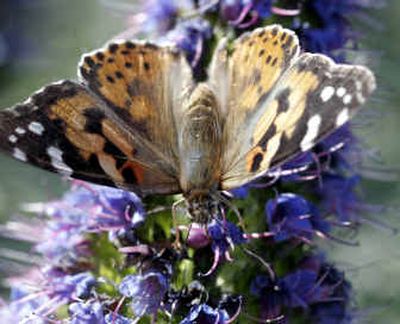Millions of butterflies invading region

SAN JOSE, Calif. – It was a gentle invasion.
“They were coming up out of a creek bed and flying over our heads,” said Sally Brandt of San Jose. “If you stood there for a minute, you’d see 50 or so. It was three or four days of this constant butterfly thing.”
Millions of painted lady butterflies are on the move in one of the biggest migrations of this species in modern times.
It started with unusually heavy rains along the U.S.-Mexico border, which caused desert plants to bloom and butterfly populations to boom.
Now the butterflies are headed north – they had gotten as far as Corvallis, Ore., last Thursday – in an annual ritual that is made more visible this year by the butterflies’ sheer numbers.
Scientists say they expect more painted ladies to stream through central California in the next few weeks.
“My estimate is there are at least a billion of them involved in this migration,” said Arthur Shapiro, an evolutionary ecologist at the University of California-Davis.
The butterflies flew through the Carmel Valley in a stream as wide as a street, passing by at a rate of more than 100 per minute, said Jerry Powell, a professor emeritus of insect biology at the University of California-Berkeley.
“They were in such big numbers in the desert,” he said, “that people were having to stop every 15 minutes to clean their windshields.”
The painted lady is one of the world’s most common butterflies – orange, black and white but smaller and less flashy than the monarch.
It is found on every continent except Australia and Antarctica.
In North America, it winters in the desert on both sides of the U.S.-Mexico border and spreads north every spring to colonize much of the United States and Canada.
A nearly identical migration takes place in Europe, Shapiro said: “Isn’t it fun to think that what is going on in our yards right now is being duplicated in Sofia or Thessaloniki or on the Riviera?”
This movement is not technically a migration, which, by biologists’ definition, requires individual animals, birds or insects to return to where they started. Instead, the painted ladies move north in waves, Shapiro said.
Each one has a store of fat as fuel, enough to last a week. And each one flies like the dickens, stopping only to rest at night.
Painted ladies even will fly over the snow-capped crest of the Sierra Nevada when the weather is nice.
When its fat supply runs out, the butterfly looks for a place to settle down and breed.
Its caterpillars are not picky eaters – they are content to chew on common weeds such as thistle and mallow.
The first wave of painted ladies should get as far north as southern Oregon.
Their offspring will continue to the Pacific Northwest and British Columbia.
Then their offspring will turn around and head south at a more leisurely pace, munching and breeding along the way.
The great- and great-great-grandchildren of the original migrants will arrive back in the desert this fall to start the cycle again.